Heritage
Kambala: How Enthusiasts And Farmers Are Keeping Alive An Old Tradition
Harsha Bhat
Feb 12, 2019, 05:24 PM | Updated 05:24 PM IST
Save & read from anywhere!
Bookmark stories for easy access on any device or the Swarajya app.
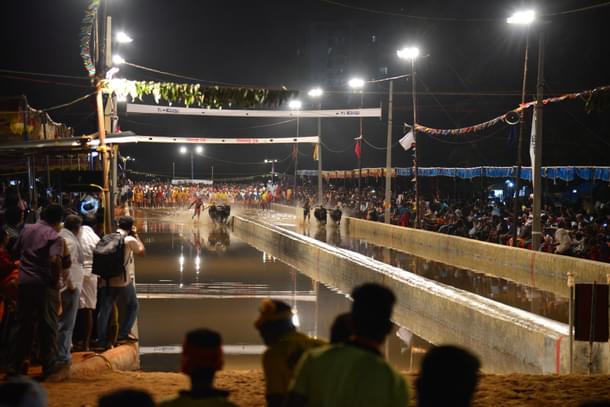
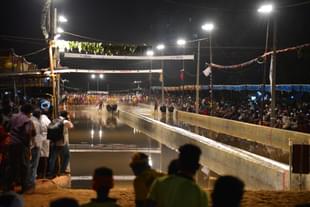
Ale budiyer! (lo, unleashed!). These words get the adrenaline pumping for anyone who has lived on the southern coast of Karnataka. They mark the beginning of the sprint of the bulls in the kambala race.
The 13-15 seconds of the sprint sees the entire audience breathing to the rhythm of the playing of the kombu (horn-trumpet), until the pair, followed by the runner, crosses the finish line, and gets onto the manjutti (mud pit at the end of the track). Hundreds of buffaloes sprint across the slushy track, while their owners watch with equal angst and pride — every kambala.
This season, when the sun makes its stride towards the northern hemisphere and the entire nation celebrates new crop, new life, the soil, the cattle and all forms of agrarian life, the region that has predominantly worshipped the sun and the moon, heralds the kambala season on the sankramana/sankranti of Tulu month Jarde, which was on 23 November last year.
But this is not what it is all about. The race is just an event, while kambala is so much more. As former president Pranab Mukherjee gave approval last year, Mangaluru city, too, which had seen all its kambala events come to a halt after legal hurdles, saw a revival.
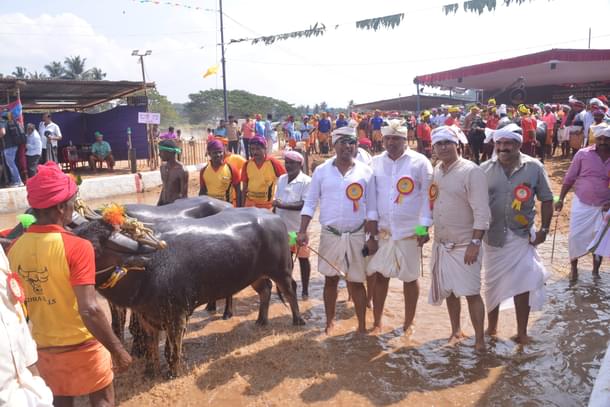
A team of young Tuluvas decided to do its bit to revive this heritage activity.
“In an age where cultural heritage is being forgotten in the name of development, we thought that if we can’t take the city youth to the villages and the kambala fields, we could get kambala to the city,” says Captain Brijesh Chowta, who led a team of youngsters and organised the first kambala in the city last year.
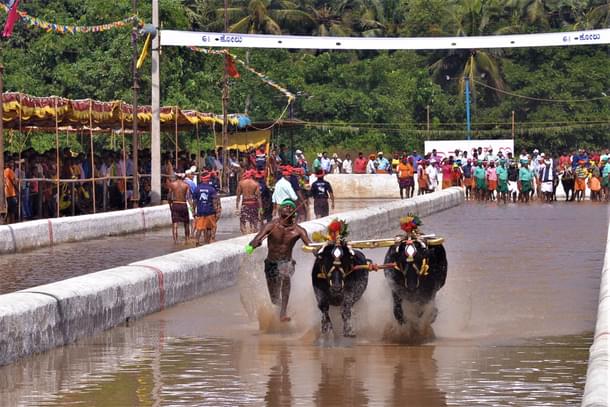
As they gear up for the second edition of Mangaluru Kambala, a floodlights event, a special kambala track is being created for the race — fields within the city have all disappeared. Areas of the city that earlier hosted the kambala are still known by the name.
Fields have made way for high rises. Kadri Kambala in the vicinity of the Kadri Manjunatha Temple was famous as Devara Kambala as it is believed that the deity from the temple came down to the fields to witness the race. It had ceased a few years ago, with the land being sold off. Thanks to those who see it not as a sport, but as part of their very existence, kambala is alive.
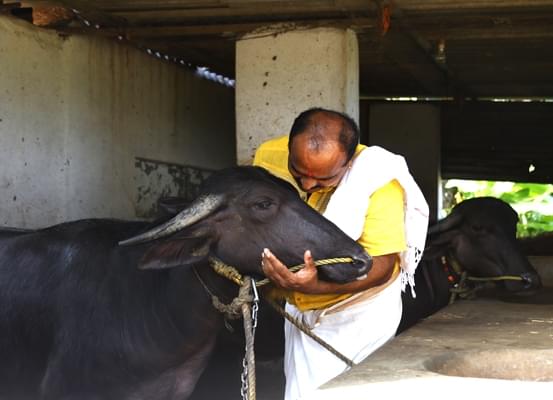
Kambala Is Not A Race, It Is A Tradition
“Kambala ota alla sampradaya,” says Tiruvailguthu Naveen Chandra Alva, as his favourite bull Raja grunts, as if in agreement. He pats the head of another young bull, the three-year-old Raja and hugs it tight, pampering him. As it rubs its head against him, Alva asks, daane maga (what son?). The bull refuses to eat the hay, sensing some unknown person is around. Alva has to then pat its head and feed it.
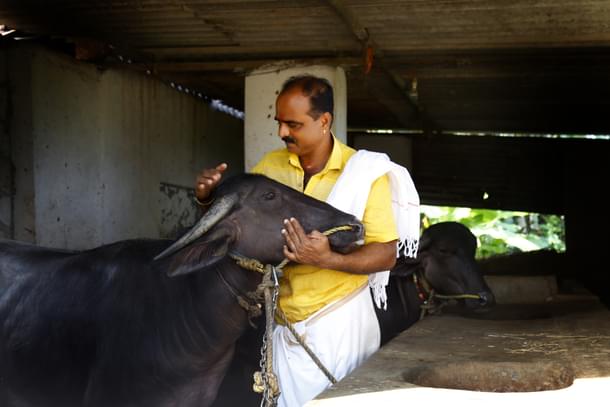
Spending a day with kambala bulls would put all the questions of animal activists to rest. For what you witness is not the relationship between an animal and its owner, but plain parenthood.
“If my wife calls and tells me my son has fever, I may ask her to head to the doctor. But if the call is to inform me about any of our bulls feeling uneasy, I head back to the house, no matter where I am,” says Alva. He talks to them in Tulu and pampers them, even as a team of caretakers carefully mixes the powdered horse gram with ole bella (palm jaggery) and feeds them.
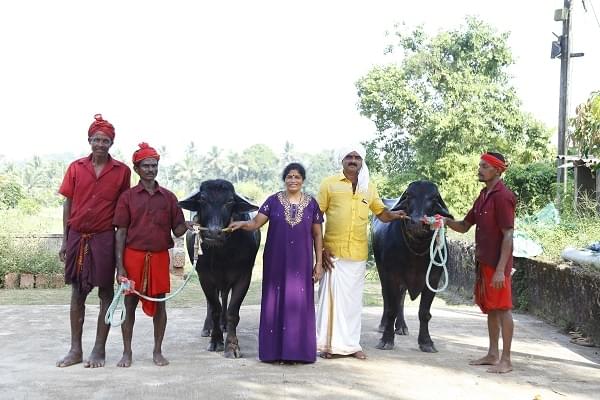
This is how the day begins for everyone at the Tiruvailu guthu mane (traditional Tulu household). Their fields are in the vicinity of Amrateshwara Temple in Vamanjoor (outskirts of Mangaluru), and their kambala is famous as Devaru Noduwa Kambala (kambala viewed by the god), as the utsava murthy of the deity is brought in procession to the field who then sets the ball rolling for the annual kambala celebrations.
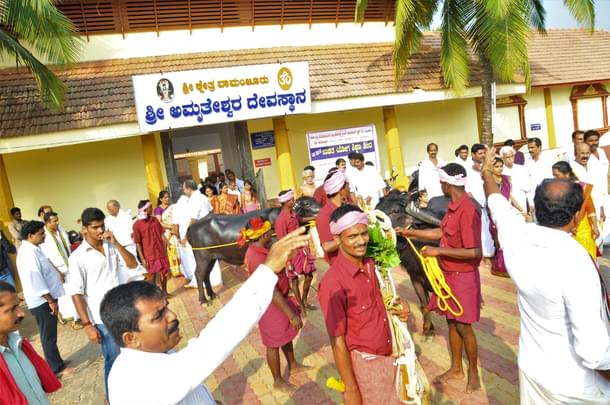
A Day In The Life Of A Kambala Bull-Owner
The day for the owner of a kambala bull very much revolves around the bull. Most owners of large fields and champion kambala bulls have a setup as elaborate as one can only imagine. Even as Alva heads to his restaurant in Mangaluru, his wife takes over the mantle. Fondness reflects in her eyes.
The day begins at sunrise around 6 am, when the bulls are given some bundles of hay, and water. As they chomp on the hay, the two-year-olds, Manju and Jaya, keep nodding, waiting to be pampered.
Half an hour later, they are given ground horse gram mixed with ole bella. Around 7.30 am, they are left to graze around a slushy spot, where they roll and enjoy the mud bath, splashing around with all four limbs in the air.
By 10.30 am, they are then given an elaborate bath, dried, and pampered with an oil massage. The oil used is a mixture of herbal and coconut oils.
Alva has three caretakers, who nurture two champion bulls and two young ones. They are then given another round of hay to chomp on. “In summer, we have special fans placed in the stable and, at times, a tank is built on top for water to drip into the stable, so it stays cool,” explains Alva. At 4 pm again, the bulls have another meal of horse gram followed by a warm water bath and a snack — of hay.
As the sun sets, the bulls and the caretakers call it a day. Alva takes pride in stating that he may not enquire if his son has had a meal, but there is not a day when he doesn’t keep a tab on the meals the bulls have had.
In Life As In Death
An eerie silence has descended on Nandalike Shrikanth Bhat’s 40-acre farm in Manipal, following the death of his most popular champion bull, Moda, on 23 November 2018. Rocket Moda, as he was called, saw hundreds of people gather as he breathed his last, and they had to postpone his funeral by a few hours, as people from various places were pouring in to get one last glimpse of the kambala champion.
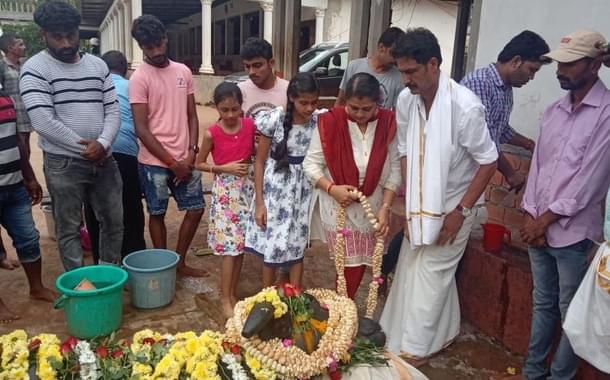
For the owners, Kolachooru Kondottu Sukumar Shetty and Bhat, who jointly keep the bulls in Manipal, Moda, like the other bulls at the farm, was family. Bhat is unable to come to terms with his death.
He chokes as he mourns the bull that had won around 200 medals. “I can’t imagine it is not there. My daughters haven’t visited the farm since he left,” he says. “He was such a huge bull, but the minute my eight-year-old daughter would be around him, he would keep his head on her lap. We have lost a family member,” he adds.
The family and people, who had gathered, gave it all the honours, and a funeral was held with rituals. Today, next to the mammoth swimming pool that the bulls wade in, is his grave, which they intend to turn into a memorial built of marble stone.
“His jodi (partner) Kutti cried and screamed. It didn’t eat for three days. Even if we tried to cajole and force feed it, it would throw up,” explains Bhat. The kambala pair of Kutti and Moda were a champion duo, and “there is none that can now take his place”. There is a junior, who is now being trained and has been named ‘Sanna Moda’ or junior Moda.
But Moda’s loyalties were of a different breed, according to Bhat. He recounts how the bull would not sleep until he called it a day, no matter what time of the night it was. “If I entered the stable, even if he was asleep, he would wake up and keep standing until I left. Once I wanted to just check and hovered around till 1 am, but Moda wouldn’t even sit down. Only once I left did he go off to rest,” says an emotional Bhat.
Community Participation
Back in the day, unlike present times, kambala saw the participation of all communities and households in the neighbourhood.
A kambala field was generally the largest in the area, which also served as a large reservoir of water that then flowed downstream into all other fields. The expanse of overly slushy soil would require ploughing at a great scale, and all in the vicinity would get a pair of their bulls.
The bulls would then sprint across the fields taking turns. In one day, the entire stretch would have been ploughed and prepared for sowing the suggi bele or the December crop.
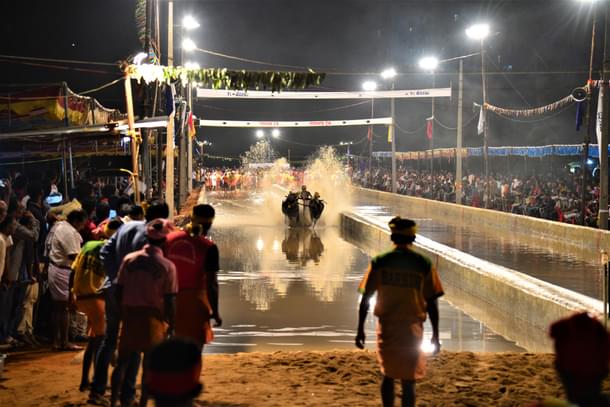
Gradually, this led to a competitive spirit among the farmers, and that’s how the concept of a kambala race came about. The landlord or the king would have to receive every farmer, who got his bull with a tender coconut and tamboola (betel nut and leaves). When the race came into the scene, the bulls that ran the fastest would be awarded coconuts and bananas.
In the case of Devara Kambala or an arasu (king) kambala, all those who owe allegiance to the deity and the landlord, would, as a gesture of loyalty and faith, get the bulls to the kambala field. Even if symbolic, they get the bulls to run one round on the field, and only then take them to their own fields for work.
The pookare or a ceremonial wooden triangular setup placed at the centre of the field marks the beginning of kambala. It is worshipped and carried to the field. The achari (wood smith) community makes the pookare, the Madiwala community takes care of its decoration with flowers available in the surroundings, and the guthu head leads the set of people, who carry the pookare to the field, install it, worship it and mark the onset of the kambala season.
There were specific roles that respective communities took upon themselves as tasks entrusted to them. Community agriculture and a sense of co-habitation were fostered by traditions like these. But sadly, none of these is visible to ‘activists’ who see it through the narrow prism of curated biases.
Indigenous Worship
Tulunadu is characterised by its spirit worship culture. Bhootarradhane or daivaradhane is a key religious belief of the land, and the sport of kambala, too, has a strong connect with this form of worship. Apart from the arasu (king), guthu (landlord), devara (god) kambala, there is also the Daivada Kambala. One of the most prominent daivas is known as Mahishandaya, or the daiva in the form of a mahisha (bull).
Traditionally, a ‘yeru banta’ — a sub-deity associated with this daiva would go around the villages, beating the drum to inform about the kambala that is to take place. His invite would then have to be honoured by all in the village and that would mark the beginning of the kambala celebrations.
Mahishandaya is seen as being central to the daivas and a temple devoted to the daiva is housed at the guthu mane. It is only with prayers and rituals conducted at the daivasthana that the kambala proceedings begin.
One has to witness the sight of the bulls kneeling down with no instructions, whatsoever, the minute the owner applies the kumkum from the daivasthana on their forehead. Call it conditioning if you may, but so is the culture.
Having sought the blessings of the daiva, the bulls get ready to make their owners proud. They are decorated with the nethi balla (forehead rope), some even sport a silver embellishment. The noga (wooden staff) is placed across their shoulders, and as they head to the track with their team of caretakers and runners, all eyes are on them.
The announcer clears the space, lists the category and the names of the owners, and declares the race open. With the call of ‘ale budiyer’, the water splashes as high as the excitement — in the eyes of those watching it. In less than 15 seconds, the bulls race past the 135 metre track and almost like a child running into the arms of the parent, the caretakers waiting at the manjutti to pacify them and wash down the slush from the run.
There is so much to kambala and its socio-cultural impact on the lives of people and the community practising it. The smallest effect can be seen in their diminishing numbers. “Many houses still have bulls only because of kambala. Already, the numbers have reduced massively,” says Alva.
“Nowhere else are the he-buffaloes or bulls nurtured, as they are here, in the land of kambala. Not only are they ‘high-maintenance’, they are often seen as ‘low-returns’, and people often hold one male-buffalo for breeding, while the rest end up in slaughter houses,” says Kambala District Samiti secretary Vijay Kumar Kanginamane.
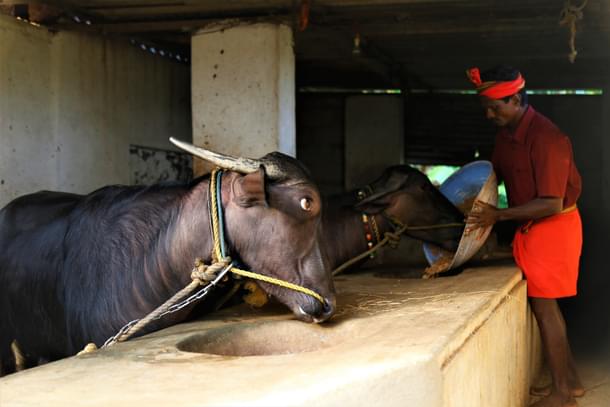
He found one such calf wandering in a locality in Bengaluru and traced its owners, who expressed their inability to take care of a male calf, but also lamented that they feared it would land at a slaughter house, soon. He then had the calf transported to his farm, and has now named it bangari (the golden one — local way of addressing someone fondly).
“Why don’t the activists who object to our traditions talk of slaughterhouses?” he asks, bruised with all the legal hassles that kambala has had to face. Kambala lovers thank Union Minister D V Sadananda Gowda, who has been supporting the cause and actively fighting to get it its due permissions.
There is no aspect of kambala that involves violence. Taming and domesticating a bull in the manner in which it is done in the region, is clearly more humane than what those accusing it of violence can ever imagine it to be.
“Why do they not come, observe and study all there is to kambala? Why do activists have to equate it to other forms of racing and races without looking at the nuances? Each region in our country has its own cultural practices, which cannot be looked at with a generalised perspective, and the right to uphold our traditions is given to us by the Constitution. How difficult is it to see this?” ask various voices in unison.
Kanginamane’s hurt is clearly a result of his passionate involvement with kambala for decades. Having also run the bulls for almost two decades (1984-2001), his attachment has been right since his childhood. “I left school for two years, just so I could participate in kambala,” he says. “No one has ever died under the feet of a bull, as it doesn’t stomp even if one falls under its feet,” he adds.
An entire generation of kambala lovers has all such tales of fondness and love with their favourite bull. Fear of an entire culture vanishing away haunts people, who are trying to keep kambala alive.
Five decades ago, there were over 450 gram panchayats in the region. Every gram panchayat had more than 150 kambala bull-owning houses. “Only 5 per cent of that now remains because of kambala. If not, we would no longer get to see these animals,” says Kanginamane.
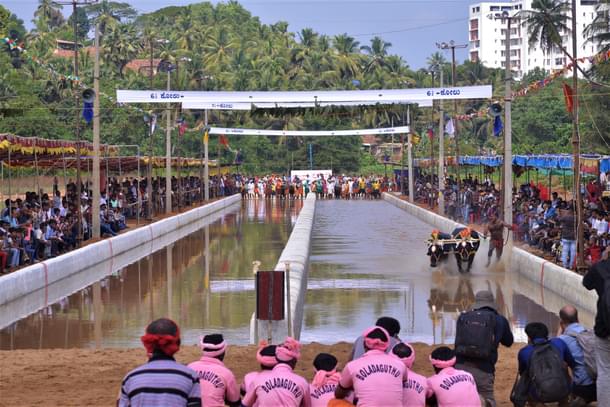
As the summer sun rises, kambala comes to an end on the sankramana of the Tulu month of Suggi (the second crop harvest season) which, this year will be held at the Soorya-Chandra tracks of Thalapady, around 23 March.
Each day, until then, all owners of the kambala bulls have their energies devoted to getting their bulls to the various kambala locations. The pampered bulls will make their ‘parents’ proud at the kambala tracks.
This article is part of Swarajya’s series on Indic heritage. If you liked this article and would like us to do more such ones, consider being a sponsor – you can contribute as little as Rs 2,999. Read more here.
Harsha Bhat is an author, linguist, content strategist, and a compulsive chronicler of Bharat's civilisational heartbeat.





